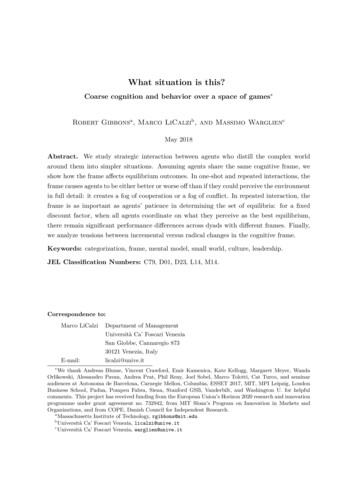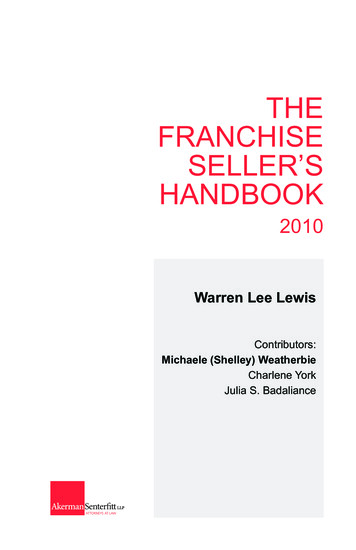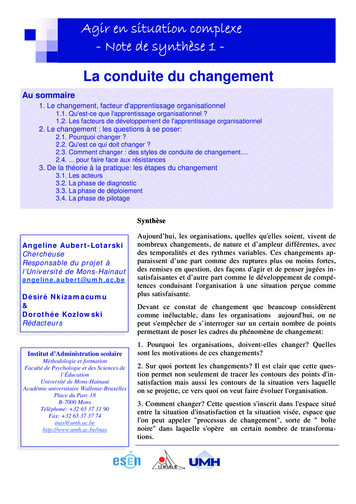
Transcription
What situation is this?Coarse cognition and behavior over a space of games Robert Gibbonsa , Marco LiCalzib , and Massimo WargliencMay 2018Abstract. We study strategic interaction between agents who distill the complex worldaround them into simpler situations. Assuming agents share the same cognitive frame, weshow how the frame affects equilibrium outcomes. In one-shot and repeated interactions, theframe causes agents to be either better or worse off than if they could perceive the environmentin full detail: it creates a fog of cooperation or a fog of conflict. In repeated interaction, theframe is as important as agents’ patience in determining the set of equilibria: for a fixeddiscount factor, when all agents coordinate on what they perceive as the best equilibrium,there remain significant performance differences across dyads with different frames. Finally,we analyze tensions between incremental versus radical changes in the cognitive frame.Keywords: categorization, frame, mental model, small world, culture, leadership.JEL Classification Numbers: C79, D01, D23, L14, M14.Correspondence to:Marco LiCalziE-mail: Department of ManagementUniversità Ca’ Foscari VeneziaSan Giobbe, Cannaregio 87330121 Venezia, Italylicalzi@unive.itWe thank Andreas Blume, Vincent Crawford, Emir Kamenica, Kate Kellogg, Margaret Meyer, WandaOrlikowski, Alessandro Pavan, Andrea Prat, Phil Reny, Joel Sobel, Marco Tolotti, Cat Turco, and seminaraudiences at Autonoma de Barcelona, Carnegie Mellon, Columbia, ESSET 2017, MIT, MPI Leipzig, LondonBusiness School, Padua, Pompeu Fabra, Siena, Stanford GSB, Vanderbilt, and Washington U. for helpfulcomments. This project has received funding from the European Union’s Horizon 2020 research and innovationprogramme under grant agreement no. 732942, from MIT Sloan’s Program on Innovation in Markets andOrganizations, and from COPE, Danish Council for Independent Research.aMassachusetts Institute of Technology, rgibbons@mit.edubUniversità Ca’ Foscari Venezia, licalzi@unive.itcUniversità Ca’ Foscari Venezia, warglien@unive.it
1IntroductionAn agent must apprehend her world before she can make decisions. Her perception generatesa representation of the environment—“[a] ‘small-scale model’ of external reality” used toformulate and evaluate her options (Craik, 1943: 61).Since Savage (1954), economics has recognized that distilling the “grand world” into a“small world” precedes rational decision-making. It is frequently assumed that the smallworld is a parsimonious but accurate model, exogenously given. Alternatively, the smallworld can result from a deliberate choice made by an agent (e.g., by allocating attentionamong different variables) or by a third party (e.g., by designing how much information isprovided). However, Savage warned that the deliberate choice of an appropriate small worldis a difficult task—“a matter of judgment and experience about which it is impossible toenunciate complete and sharply defined general principles” (1954: 16).Cognitive science goes further than economics on this question: it is widely agreed thatagents distill the environment into partial representations and that agents’ mental modelsdepend on cognitive mechanisms that usually escape conscious control. For example, Allport(1954: 20) stated that “the human mind must think with the aid of categories. Once formed,categories are the basis for normal prejudgment. We cannot possibly avoid this process.” Inshort, in the cognitive approach, the small world cannot be attributed to a deliberate choiceand need not be accurate.In this paper, we develop and analyze a model of how agents’ partial representations affecttheir strategic behavior and hence their performance. Motivated by the cognitive approach,our main goal is to explore the role of “small-scale” mental models in strategic interactions.Our model can also be interpreted in terms of information design and thus nests a version ofthe economic approach as well.We study two agents who engage in strategic interaction using a shared mental model.The environment is an uncountable space G of games. Each agent distills G into a finitenumber of categories called situations. The collection of situations is a partition of G, whichwe call the agent’s frame.1 The frame-based cognition of G is coarse, because the framereduces an uncountable set to a finite partition.Under our economic approach, the frame is exogenously given or follows from knownchoices: when a game from G is realized, an agent learns only which situation has occurredand updates her belief accordingly. We call this case generative because the agent’s frame is1We borrow this term from Bacharach (2003: 63), who defines it as “the set of concepts an agent uses inthinking about the world” and assumes that a frame induces a partition. Less formally, Goffman (1974: 21)uses this term to connote “schemata of interpretation” that allow agents to “locate, perceive, identify, andlabel” events in the world around them.1
generated by an information structure known to the agent. The generative case is consistentwith the “metaphorical” interpretation of information design (Bergemann and Morris, 2017:5).Under our cognitive approach, in contrast, agents have no access to the cognitive processthat produces their mental representation: they are unaware that they are framing, and theycannot imagine that others perceive the world differently. More precisely, they know only (i)the set of situations that could be realized and (ii) which one has been; they are not awareof the underlying games in G. We call this case interpretive because the frame summarizeshow agents interpret their environment.2We expect the generative and interpretive cases to differ substantially in most settings.The analysis in this paper, however, applies to both cases because we assume that the partiesshare the same frame. In the generative case, this occurs when the information structure issymmetric; in the interpretive case, the shared frame may be culturally determined, as wediscuss below. In either case, conditional on what their frame lets them perceive, agents havecorrect beliefs and play their dominant strategy. Because we assume that two agents sharethe same frame, we focus on comparing behavior across dyads with different frames.We provide three main results. First, in a one-shot interaction, the coarse representationinduced by a frame can either decrease or increase the parties’ payoffs, compared to havingfull information about the environment. We say that the shared frame may induce eithera fog of conflict or a fog of cooperation. In the generative case, this implies that limitingaccess to information can make both agents better (or worse) off. In the interpretive case,it suggests that performance differences may be due to differences in cognitive frames acrossdyads.Second, we consider a repeated interaction. In each period an independent draw from Gselects (a) the game the parties actually face and (b) conditional on their shared frame, whichsituation they perceive. Assuming an infinite horizon and subgame perfection, standard arguments allow the parties to increase their payoffs above the static level if they are sufficientlypatient. We focus on the opposite comparative static: fix the parties’ discount factor δ andanalyze how their frame affects payoffs in a repeated interaction. We find that, for fixed δ,there are frames under which the parties’ highest equilibrium payoffs are greater (or lower)than in a repeated interaction under full information. In this respect, the configuration ofthe situations induced by a frame, called the frame’s footprint, is as important as discountingin facilitating cooperation.2Our terminology is similar to Hong and Page (2009: 2175), who suggest that “generated signals [. . .] arepassively received by the agents, [whereas to] create an interpreted signal, an agent filters reality into a set ofcategories.”2
Third, we investigate the dynamics of changes in the shared frame within a dyad. Wedistinguish between incremental change, when only the footprint of the situations perceivedby the parties varies, but not the dominant action in a given situation, versus radical change,where both the footprint and the action vary. When the cost of reshaping the footprint isincreasing in the size of the change, the optimal change in frame may be incremental andlead to lower gross payoffs than a radical (but expensive) change would. When changes inthe frame are costless but of uncertain effectiveness, we illustrate how behavioral inertia aftera radical change may have perverse effects on short-term performance.Framing this paperWe take two inspirations from economics and one from cognitive science. First, at the individual level, we follow Simon (1986), Kreps (1990a), and Rubinstein (1991) by separatingcognition from behavior. Simon (1986: S211) cautions that “we must distinguish betweenthe real world and the actor’s perception of it and reasoning about it.” Kreps (1990a: 155)explicitly separates cognition and (rational) behavior: “the individual builds a model of hischoice problem, [. . .] which is typically a simplification or a misspecification (or both) of the‘true situation’. The individual finds his ‘optimal’ choice of action within the framework ofthis model and acts accordingly.” Finally, Rubinstein (1991) calls for game-theoretic modelsto account for what agents perceive.Second, at the group level, we follow Denzau and North (1994), Aoki (2001), and Ostrom(2005) by emphasizing the shared mental models that can be held by individuals with commonbackgrounds or experiences. Denzau and North (1994: 5) argue that the experiences of pastgenerations are distilled into “a culturally provided set of categories and priors.” Aoki (2001:235) discusses how shifts in equilibria are associated with changes in the parties’ “commoncognitive representations,” and Ostrom (2005: 106) emphasizes that “cultural beliefs systemsaffects the mental models that individuals utilize.” More recently, Hoff and Stiglitz callfor economic analyses to consider “socially constructed cognitive frames” (2010: 141) and“cultural mental models [such as] concepts, categories, social identities, [and] narratives”(2016: 26).Finally, from cognitive science, we follow a wide consensus that subjective representationsmediate between perception and choice: “we have mental structures, especially schematicrepresentations of complex social phenomena, which shape the way we attend to, interpret,remember, and respond emotionally to the information we encounter and possess”’ (DiMaggio, 1997: 273). We focus on categories as a basic form of such cognitive simplifications:“categorization is the mental operation by which the brain classifies objects and events [and]this operation is the basis for the construction of our knowledge of the world” (Cohen and3
Lefebvre, 2005: 2).Related literatureCategorization is not new to the economics literature. For example, Mullainathan et al. (2008)and Fryer and Jackson (2009) use categorization to model coarse cognition; Wernerfelt (2004),Crémer et al. (2007), and Blume and Board (2014) use it to model coarse language. Anotherstrand of research studies categorization of the elements of a given game; e.g., in Jehiel (2005)each player partitions the opponents’ moves into similarity classes. We focus our review oncontributions where the categorization concerns different games, because this case is closestto ours.Heller and Winter (2016) assume that each agent initially and simultaneously decides acategorization over a finite set G of two-player games, committing to play the same strategyfor all the games in the same category. Categorizations may be part of a subgame-perfectequilibrium and the strategic value of choosing a coarser partition can be positive, akin toour fog of cooperation.Categorizations might emerge from an evolutionary process. Mengel (2012a) studies theevolutionary fitness of different cultures (viewed as different partitions of the game space)under the assumption of persistent noise in the transmission process across generations. Ourmodel shows that categorizations can be advantageous even when errors play no role.Samuelson (2001) studies finite automata that bundle bargaining games to save cognitiveresources for more demanding games. Mengel (2012b) considers two players with arbitrarysmall reasoning costs who, under reinforcement learning, end up bundling games into categories that are then played identically. Bednar and Page (2007) use agent-based simulationsto demonstrate that different rules of behavior emerge when different pairs of games arebundled in the same category.Moving from theory to experiments, psychology has produced a vast literature on categorization in individual decision-making (Cohen and Lefebvre, 2005), but categorization hasattracted far less attention within games. Halevy et al. (2012) show that individuals mapthe outcome interdependence from a variety of conflicts to only four archetypal situations.Grimm and Mengel (2012) provide evidence of learning spillovers across six games and matchit to a model of coarse partitions of the space of games where agents best reply to the “average game” in each category; see Bednar et al. (2012) and Huck et al. (2011) for relatedexperimental results. This perspective is consistent with our key assumption that playerscategorize games into coarse situations.4
2The modelWe study an environment involving symmetric interactions where rational agents will eithercooperate (as in common-interest games) or compete (as in zero-sum games). When theseclear-cut interactions are conflated, interesting tensions can emerge.For example, the prisoners’ dilemma (PD) can be associated to a lottery between acommon-interest (CI) game and a zero-sum (ZS) game; see Kalai and Kalai (2013). Considerthe interaction between two parties facing a 50–50 lottery over the CI and ZS games below.HLH10, 106, 6L6, 62, 2HLH0, 0 6, 6L6, 60, 0CIZSThis interaction is best-reply equivalent (Morris and Ui, 2004) to the PD gameHLH5, 50, 6L6, 01, 1PDbased on the expected payoffs from the lottery. The cooperation motive in the CI gameencourages agents to play (H, H), while the competitive motive in the ZS game suggeststhey play (L, L). Given the payoffs in the CI and ZS games above, when the lottery putsprobability p 1/2 on the CI game, the cooperative motive is weaker than the competitiveone. The cooperative motive would instead prevail for p 3/5.We generalize this example by considering CI games with payoff parameter a 0 andZS games with payoff parameter z 0. In the game G(a, z; p) shown in Figure 1, the twoparties face a CI game with probability p and a ZS game with probability 1 p.HLHa, a0, 0L0, 0 a, aHLCIH0, 0z, zL z, z0, 0ZSFigure 1: Nature draws CI or ZS, with probabilities p and 1 p.Assuming that the parties move before uncertainty is resolved, the game G(a, z; p) withimperfect information is best-reply equivalent to the game below.5
HLHpa, pa (1 p)z, (1 p)zL(1 p)z, (1 p)z pa, paDefiningπ a,a zthe dominant strategy for each party is to play H when π 1 p and L when π 1 p.From a strategic viewpoint, it is therefore possible to reduce the number of dimensions fromthree to two: there is a projection from the (a, z; p)-space to the (π, p)-space that preservesbest replies, while losing information about payoffs. Under this projection, (π, p) is the(representative) element for a class of games that are best reply-equivalent. Therefore, withsome abuse of language, we refer to (π, p) as a game.We assume that p is uniformly distributed on [0, 1]; moreover, a and z have independentexponential distributions with parameter λ 1, so π a/(a z) has a uniform distributionon [0, 1]. The bidimensional space of games G [0, 1]2 is thus uniformly distributed andis depicted in Figure 2. Any game with π 1 p is a CI game where H is the dominantpCIHLZS0πFigure 2: The space G of games.strategy, and any game with π 1 p is a PD game where L is the dominant strategy.3As a benchmark, in this paragraph we consider the case where each party perceives anygame drawn from the space G as distinct and plays the appropriate dominant strategy inwhatever game is drawn. The expected payoff is 1/3; see Proposition A.1 in the Appendix,where we have collected theorems and proofs.We henceforth assume that each dimension of the space G—the payoff ratio π in [0, 1]and the probability p in [0, 1]—is too rich to allow either party to perceive all its elementsas distinct. Instead, each agent apprehends each dimension by means of a categorizationthat bundles uncountable points into a finite number of intervals. For simplicity, we workwith binary categorizations, respectively defined by the thresholds π̂ and p̂. Thus, an agent3One may reformulate the space of games as a single game with payoff uncertainty.6
categorizes π as High (h) if π π̂ and Low ( ) if π π̂; similarly, p is High (h) if p p̂ andLow ( ) if p p̂.4An agent with binary categorizations for π and p perceives four cells, as depicted inFigure 3. We call each of the four cells a situation. A cell bundles together many games, allpp̂ZS0S4S1S3S2CIππ̂Figure 3: A categorization of G into four situations.of which are perceived by a party as instances of the same situation. That is, when an agentfaces a game from G and wonders “what kind of situation am I in?”, only four answers cometo her mind. For example, the northeastern cell S1 corresponds to the situation where bothπ and p are perceived as h. If she views the dimension π as the (relative) salience of thecooperation payoff and the dimension p as the (likelihood of the) opportunity for cooperation,the situation S1 involves high salience and high opportunity. The other three situations havesimilar interpretations.The frame of an agent is the collection of the situations that she perceives, identified bythe threshold pair (π̂, p̂). In the generative case, the frame is a direct consequence of theinformation structure, which is known by the agents. In the interpretive case, she simplyperceives a game (π, p) as a situation, described by each of the dimensions π and p takingvalue h or : only the model-builder, not the agent, knows that the agent (a) categorizesgames and (b) does so via the threshold pair (π̂, p̂).Throughout this paper, we assume that interacting parties share the same frame (π̂, p̂): ineach of the four situations associated with the frame, they perceive a single 2 2 symmetricgame with payoffs equal to the expected payoffs from all the games ascribed to that situation.5In sum, agents’ strategic understanding of the space of games G is coarsened into the foursituations S1 , S2 , S3 , S4 in Figure 3. Using Lemmata A.2 and A.3, the expected payoffs tothe first party (rescaled by a factor of 2) are shown in Figure 4 for each of the four situationsperceived under the frame (π̂, p̂).4Which categorization applies at π π̂ or at p p̂ is immaterial, because this event has zero probability.Conditional on the frame, the agents have correct beliefs about the distribution of payoffs in each situation.In the generative case, this occurs because they can compute this distribution. In the interpretive case, we57
HLHπ̂ 2 (1 p̂2 )π̂(2 π̂)(1 p̂)2L π̂(2 π̂)(1 p̂)2 π̂ 2 (1 p̂2 )HLH(1 π̂ 2 )(1 p̂2 )(1 π̂)2 (1 p̂)2S4HLHπ̂ 2 p̂2π̂(2 π̂)p̂(2 p̂)L (1 π̂)2 (1 p̂)2 (1 π̂ 2 )(1 p̂2 )S1L π̂(2 π̂)p̂(2 p̂) π̂ 2 p̂2HLH(1 π̂ 2 )p̂2(1 π̂)2 p̂(2 p̂)S3L (1 π̂)2 p̂(2 p̂) (1 π̂ 2 )p̂2S2Figure 4: Perceived payoffs in the four situations under the frame (π̂, p̂).After playing a perceived situation, the parties receive the payoffs associated with theactual game drawn: either CI with probability p or ZS with probability 1 p from Figure 1.In the interpretive case, they ascribe the difference between the expected payoff and therealized payoff to noise.We intend the interpretive case of this model as one way to capture differences—sometimesattributed to “culture”— in how agents perceive not only what situation they are in but alsowhat the likely consequences of alternative actions are. By assuming that two agents sharea frame, we imagine them coming from the same culture.3One-shot interactionThis section considers the one-shot interaction between two parties under a shared frame(π̂, p̂), with π̂ p̂ 6 1. We label the northeast and southwest situations S1 and S3 congruous,because their descriptors π and p are both high or both low: the salience of cooperation πand the opportunity for cooperation p are aligned. In contrast, we say that the two situationsS2 and S4 are incongruous because their descriptors are misaligned: one is high and the otheris low.Rational behavior in the two congruous situations is unequivocal. Figure 4 shows that thesituation S1 is always perceived as a CI game under any frame (π̂, p̂), so H is the dominantstrategy. Similarly, the situation S3 is always perceived as a PD game, so L is the dominantstrategy. In short, regardless of the frame, rational behavior for a party facing a congruoussituation is to play H in S1 and L in S3 .Assuming that the frame satisfies π̂ p̂ 6 1, we find that there is also a unique dominant strategy for the incongruous situations S2 and S4 . This is characterized in the nextproposition, which is an immediate corollary of Proposition A.6 in the Appendix.assume that the cognitive process selecting their frame also provides them with correct beliefs about payoffs.8
Proposition 1. The unique dominant strategy for both S2 and S4 is H if π̂ p̂ 1, and itis L if π̂ p̂ 1.Unlike the congruous situations, the dominant strategy for the incongruous situations dependson the frame.Combining the dominant strategies over the four situations, we find two rational rules ofbehavior, shown in Figure 5. The first rule, depicted on the left, is optimal if π̂ p̂ 1: playH in any situation except S3 , and then play L; we call it the OR rule, because it prescribesplaying H when either π or p is perceived as high. The second rule, shown on the right,is optimal if π̂ p̂ 1: play H only in S1 and otherwise play L; we call it the AND rule,because it prescribes playing H only when both π and p are perceived as high.ppHHLHCIp̂ZS0π̂LHLLZS0πCIπFigure 5: The OR and AND rules of behavior.Since the frame is shared and payoffs are symmetric, the parties will play the samestrategy in a given situation. If π̂ p̂ 1, they will play (H, H) in all situations except S3and (L, L) in S3 (OR rule); if π̂ p̂ 1, they will play (H, H) only in S1 and (L, L) otherwise(AND rule). Therefore, different frames can induce different strategy profiles when partiesencounter incongruous situations.Having computed optimal strategies, we next analyze how the parties’ expected payoffsdepend on the thresholds (π̂, p̂) of their shared frame. First, payoffs change continuously in(π̂, p̂) unless the thresholds induce a switch in the parties’ rule of behavior; second, if the ruleof behavior switches, then there is a discontinuous change in payoffs.Proposition A.7 gives the expected payoff to each party as a function of π̂ and p̂. As anillustrative example, suppose π̂ p̂ x so that a change in x makes the thresholds shift inlockstep. The parties play the OR rule for x 1/2 and the AND rule for x 1/2. Figure 6shows the payoff to each party as a function of the common value x for the two thresholds.Within either the OR or the AND region, payoffs are continuously decreasing in x. On theother hand, moving x leftward across 1/2 implies an abrupt drop in payoffs, as the partiesswitch to the less cooperative AND rule of behavior. Nonetheless, depending on x, the AND9
OR OR AND AND Umax payoff1/30benchmark1 x1/2Figure 6: Payoffs as a function of x when π̂ p̂ x.rule may outperform the OR rule.Framing games as situations can either help or hurt the parties’ payoffs, relative to thebenchmark case where each game is perceived as distinct. This is apparent in Figure 6, wherethe benchmark payoff of 1/3 cuts across the payoff curve. Intuitively, one may think of theframe as creating a fog that confounds different games into a single situation, forcing a partyto deal with all such games in one way. Depending on the frame, the result is either a fogof conflict (marked ), making agents play less cooperatively than they would under fullinformation, or a fog of cooperation (marked ), making them play more cooperatively. Notethat either fog can occur under either rule of behavior, so frames evidently do more thandetermine rules of behavior.We can identify which frames generate which kind of fog. Proposition A.8 states formallya simple characterization, but the main message is conveyed through a picture. Each frameis associated with a threshold pair (π̂, p̂) in [0, 1]2 so the unit square in Figure 7 stands forthe space of the frames. We emphasize that Figure 7 does not portray the space G of thegames (π, p), but rather the set of threshold pairs (π̂, p̂) that define a frame.6The OR rule prevails when the parties’ shared frame is a threshold pair (π̂, p̂) above thediagonal, while the AND rule prevails when it is a pair below. The curve above the diagonalseparates the OR region into the shared frames (π̂, p̂) generating a fog of conflict (marked ) versus those generating a fog of cooperation (marked ). Similarly, the curve below thediagonal separates the AND region into fog of conflict (marked ) versus fog of cooperation(marked ). Consistent with the special case depicted in Figure 6, moving from northeastto southwest within a rule in Figure 7 improves payoffs continuously; on the other hand,crossing the boundary coming from the OR into the AND rule causes a discontinuous drop6One of us enjoys the mnemonic “put your hat on” when keeping track of p versus p̂.10
p̂OR OR AND AND 0π̂Figure 7: Fog of cooperation ( ) and fog of conflict ( ).in payoffs. Switches in the rule of behavior motivate part of our discussion about changingframes in Section 5.As one way to summarize the interpretive case of this static model, we find it useful toimagine two parties who share a low-performing frame arranging a site visit to observe twoother parties who share a high-performing frame. All parties perceive situations in termsof their own categorizations; the low-performing parties observe the actions chosen by thehigh-performing parties.As a dramatic example, consider the discontinuity at x 1/2 in Figure 6, and supposethat the low- and high-performing frames have x .45 and x .55, respectively. For allthe games (π, p) from the set (.45, .55) (.45, .55), the low-performing parties perceive thesituation S1 and hence a CI game, expecting the high-performing parties to choose (H, H),while the high-performing parties perceive the situation S3 and hence a PD game, leadingthem to choose (L, L). Thus, on this set of games, the high-performing team does worse.The more important difference cuts the other way: in the incongruous situations the highperforming parties perceive a CI game and so choose (H, H), whereas the low-performingparties perceive a PD (even for games when both teams agree that an incongruous cell hasbeen realized) and so choose (L, L). In sum, the low-performing parties will be mystified bythe site visit: when they see CI, they observe their hosts playing (L, L) with small probability;and when they see PD, they observe their hosts playing (H, H) with larger probability.We see the interpretive case of this stylized model as a small step towards understanding widespread evidence of differences in cooperation during evolution (Boyd and Richerson,2009) and among cultures (Henrich et al., 2005), communities (Ostrom, 1990), firms (Leibenstein, 1982), organizations (Schein, 1985), and teams (Cole, 1991). Moving from the field tothe laboratory, experiments show that cultural frames differ in how they perceive situationsas “cooperative” or “competitive” (Keller and Lowenstein, 2011) and how inducing differentframes affects cooperation levels (Pruitt, 1970; Liberman et al., 2004). Many explanations11
of such differences in cooperation emphasize differences in preferences; we provide a complementary explanation based on differences in shared cognition which, in turn, might arisefrom cultural differences.4Repeated interactionHaving constructed a model where shared frames shape behavior in static situations, wenext consider the case of infinitely repeated interactions. Under any frame, the congruoussituation S3 is perceived as a PD. Furthermore, if π̂ p̂ 1, then the incongruous situationsS2 and S4 are also perceived as PDs. In a repeated interaction, familiar logic might allowthe parties to cooperate in some or all of these PDs, even if they would defect in a one-shotinteraction.We analyze such opportunities for long-term cooperation using a multi-period model,where in each period the stage game is randomly drawn from the space G of games andperceived as one of four situations under the shared frame (π̂, p̂). As in the static model,given their frame, the parties have correct beliefs: before a game is drawn in a given period,the parties expect to face situation S1 with probability (1 π̂)(1 p̂), situation S2 withprobability (1 π̂)p̂, situation S3 with probability π̂ p̂, and situation S4 with probabilityπ̂(1 p̂). We assume that the parties have the same discount factor δ 1, and we rescaletheir discounted payoffs by a factor (1 δ) to make them comparable to the one-shot payoffs.We analyze subgame-perfect equilibria in trigger strategies where defection (i.e., playingL) in a PD situation is met by defection in all future PD situations, discarding the possibilitythat punishment calls for a party to play (the dominated) action L in a CI situation. We areespecially interested in the case of full cooperation, when agents play (H, H) everywhere.As above, we brief
E-mail: licalzi@unive.it We thank Andreas Blume, Vincent Crawford, Emir Kamenica, Kate Kellogg, Margaret Meyer, Wanda Orlikowski, Alessandro Pavan, Andrea Prat, Phil Reny, Joel Sobel, Marco Tolotti, Cat Turco, and seminar











